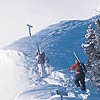Sharing Paradise

As a kid growing up in Aspen, I didn’t know-or care-who first skied Highland Bowl. It was big, wild, off-limits and it scared the spit out of me-and that’s all that mattered. Highland Bowl has loomed large in the consciousness of a lot of skiers in Aspen over the years because it is a thing of great and terrible beauty. Skiing it, for those who were brave or foolish enough to do so, was a rite of passage for local hardcore skiers.
On my first visit to the bowl in the early ’70s, it was legally out-of-bounds and logically beyond the pale. It’s one of those rare slopes that’s as radical up close as it appears to be at a distance. It was unpatrolled and unmaintained-and spectacularly unsafe. We could have easily died, but the luck of the innocent ran stronger with us than we would ever know. Our reasons for being there were the usual: massive terrain, untracked snow, big adventure-and the chance to say we’d done it. We would make the only tracks on it that day and, in fact, some of the only ones that year.
When I first heard that the Aspen Skiing Company intended to officially open the bowl to all comers last season, it seemed unbelievable to me, even though the resort had been moving in that direction since the late ’90s. For many years, whenever tracks appeared in this huge, hike-to caldera that crowns Aspen Highlands ski area, they were considered an act of brazen stupidity. Local skiers knew the bowl could, and would, slide horrifically. Three skilled, experienced Highlands patrollers died in a massive avalanche there in 1985. But when you saw tracks you also knew that whoever made them got good turns. Epic, heart-racing, copper-tasting, deeply erotic turns.
With insane pitches of 35 to 48 degrees, above-timberline exposure, tricky wind-loading and convex to concave slopes pointing in just about every direction, Highland Bowl always seemed like an insane bet to go commercial. The severe avalanche control issues looked plainly insurmountable. But I underestimated the determination and dogged grit of the Highlands ski patrol.
Patrol Director Mac Smith and his crew, with the blessing of mountain manager Ron Chauner, viewed the bowl as a personal challenge. In 1997, they began dropping the rope on progressively larger slices of the bowl as they made them safe-primarily through the grunt work of months of boot-packing and frequent application of explosives.
When you’ve grown up lucky enough to have had something like Highland Bowl virtually to yourself for three decades, you greet its opening with ambivalence-a mixture of awe and dread. I didn’t believe it could be done, and I hated the thought of hordes of people in it. It’s selfish, but there you have it. Had there been a vote on opening the bowl, I would have pulled the “No” lever. But Mac Smith, to his credit, believes that sharing is good karma. He knew great skiing was waiting at the bowl, and he thought his friends and the community deserved to enjoy it.
For people who have lived to see their favorite places being shared to death, however, it’s a difficult concept to accept. Yet it’s also what we work for, to see everybody get a chance to experience magnificent and exciting wild country. First, because it’s a rush. Second, because if people don’t, they’ll never know why it’s special and worth preserving. This is an old conflict in the mountains: running the risk of destroying a place to save it. But maybe we run the risk of opening these special places in order to save them all.
True, now some days the route up the Highland Bowl ridge looks like the line to Space Mountain at Disney World. But I also stood alone at the summit on more than one powder day last winter. It’s still a lung-scorching 30-minute hike to reach the 12,386-foot summit-and there are no easy routes down. With the final section of the bowl now accessible, they’ve saved the best for last. These are the pure north-facing slopes, ranging from summit shots to steeply timberred glades, and they hold the lightest, deepest, most savory snow in the valley.
Last season, blessed with a benediction of powder, the entire bowl was exceptional, which reinforced my love for its pitch, its snow and its quiet woods. And I think it’s good that any skiers willing to earn their turns now have that opportunity. Those who stenciled the first tracks on Highland Bowl may not have wanted me-and a thousand others-to come after them. But the bowl’s fate wasn’t in their hands. If other people now get to ski Highland Bowl and linger in my paradise more often than I have, so be it. It is, I fear, the nature of paradise to be found, not lost. And in the end, I don’t even care if they save some for me, as long as we save some for everyone.